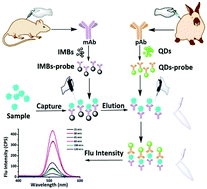Ultrasensitive detection of H. pylori in human feces based on immunomagnetic bead capture and fluorescent quantum dots †
Abstract
Given that Helicobacter pylori (H. pylori) generally infects people in early childhood and that such persons when not treated with antibiotics remain infected for the rest of their lives, it is quite important to detect H. pylori in children, and convenient to do so using non-invasive methods. Stool antigen tests constitute such an effective non-invasive method. In the current work, a novel fecal test was developed to detect H. pylori based on immunomagnetic beads (IMBs) with monoclonal antibodies sensitively recognizing and capturing the H. pylori, coupled with a polyclonal antibody-conjugating quantum dot probe, and ultrasensitive detection was achieved by using a fluorescence spectrometer. The detection method took 120 min to perform, and showed a limit of detection of 102 CFU mL−1 and a linear range of 10 to 106 CFU mL−1 (R2 = 0.9962). Most importantly, this method can be effectively applied to real samples. This study provided a novel method for the non-invasive detection of the fecal antigen H. pylori.



 Please wait while we load your content...
Please wait while we load your content...